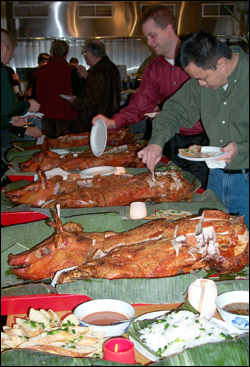Monsoon may seem an odd name for a restaurant. But you couldn’t find a more apt name for Seattle’s Monsoon, which threw a fifth birthday party for itself last week, with a roast pig for every year and many of the town’s top professional food-and-wine folk on the guest list.
In South and Southeast Asia, the monsoon is the drenching rain that comes to break the drought, a time when life abounding returns to the parched earth. Dining at Monsoon has a similar revivifying impact, even if you’re a pampered diner who’s never experienced even metaphorical drought. Eric Banh’s cooking refreshes a jaded palate, reminding one that great eating has nothing to do with complication or exaggeration, let alone excess.
It’s hard to say just how Banh does it. Marvelous ingredients help; a mastery of the culinary techniques of two if not three cultures (Vietnamese, French, American) contributes mightily. An artist’s eye for the look of a dish helps. Abstractions are dangerous when discussing something as visceral as food, but categorizing Banh’s cuisine forces me to use some: simplicity allied to balance, poise, grace, yet able constantly to surprise. Eating one’s way through a Monsoon meal is a little like lingering at a career retrospective of a master like Matisse: an incredible profusion of diverse sensations and effects unified by a single personality.
Looking back recently at old Monsoon menus, I was startled by how Banh’s cooking has expanded from its core competence in Vietnamese ingredients and preparations. It was never conventional—how does one categorize “wok flank beef and bamboo shoot with oxtail stock” (from summer 2001) or (from 2003) “honey walnut gulf shrimp with tangerine mayo”? Today all the classic herbs and seasonings of Southeast Asian cooking are still present—more present, even, because fresh exotic produce has recently become so much easier to purchase—but they are now just one dimension of the range of flavors and textures afforded by a Monsoon meal.
These days, the foreground of Banh’s cuisine is dominated by fresh local ingredients, many of which simply don’t occur in tropical and subtropical eastern fields and waters: salmon, scallops, halibut, free-range lamb and boar, jicama, and morel mushrooms share the stage with Southeast Asian staples like chicken, shrimp, pork, long beans, peanuts, and papaya. Rarely does a dish suggest a single provenance. That’s just Banh—doing his thing.
For one Monsoon regular, the most distinctive culinary hallmark of Banh’s cooking is his use of curries. “They’re never assertive and in-your-face. They always complement the other flavors in the dish. Eric says that piling on the hot spices just masks the taste of the other ingredients. Maybe that’s why so many places do it; to cover up the fact that they’re using less than first-rate materials. I know for a fact that his food costs are exceptionally high. A lot of restaurants try to keep them down to 20 percent or so; I bet his regularly go over 30.”
Another element setting Monsoon’s cuisine apart is its dependence on wine for full effect. Many fine “Western” restaurants do not have such an extraordinary list, with so many intriguing oddities and rarities. But the full power of the list only comes into focus when you allow Banh to select your wine for you. Added dimensions of flavor come shimmering out of the food, like a landscape emerging from the mist.
In fact, the best way to enjoy Monsoon is simply to let Banh choose your meal for you as well as the wine you drink with it. (If he’s not on duty, you can trust your server almost as well. After all, they eat the same food the customers do, and daily; it would be surprising if they didn’t know their way around its nuances.)
But there’s no question that Monsoon shines brightest when the boss is in residence. Other members of the staff, Banh’s sister Sophie in particular, contribute their grace notes to the cuisine, but Monsoon is his baby and his performance space and, more so than the tiny exposed kitchen, its austerely furnished rectangular dining room is the stage where the performance unfolds. There are many fine restaurants whose atmosphere is saturated by one sensibility, restaurants as different as Brad Inserra’s funky Swingside Cafe and Scott Carsberg’s très elegant Lampreia. But I don’t know another where the atmospheres on both sides of the counter are as harmonious as Monsoon’s. Eric Banh is not just a culinary magician, he is a supremely agreeable man, and his decency, modesty, and cheer are the ultimate condiments for his meals.








